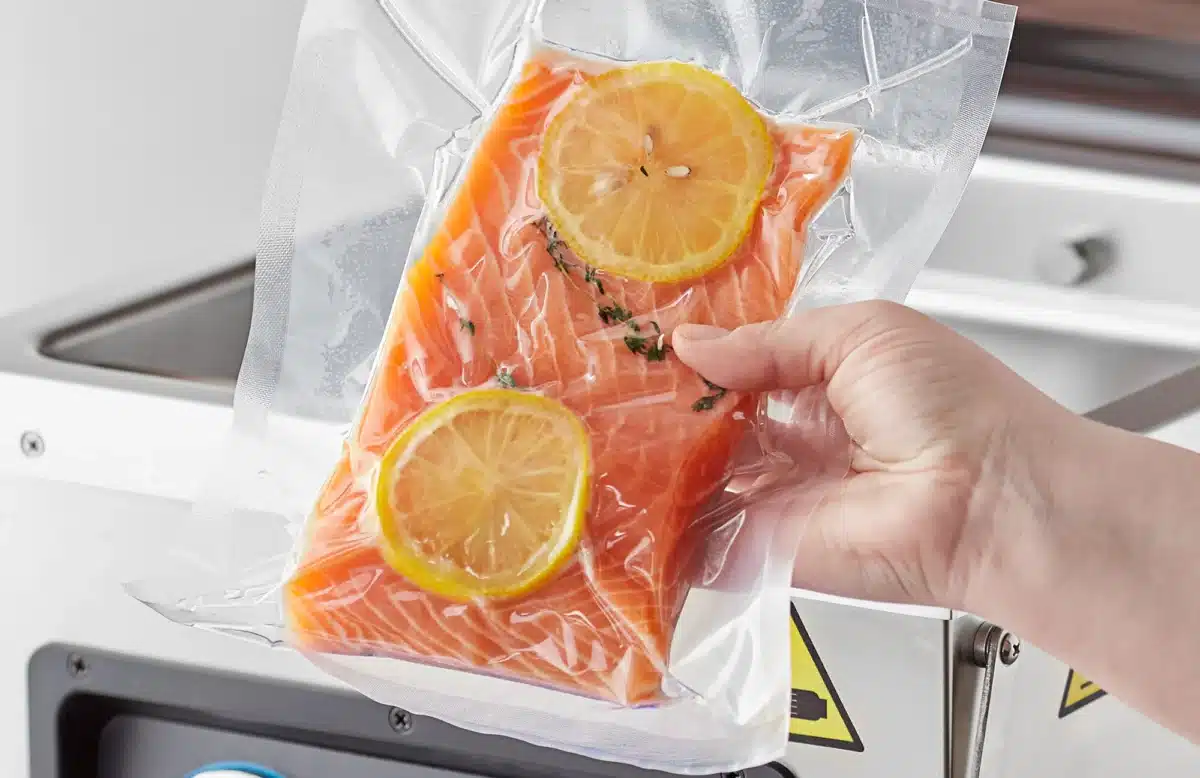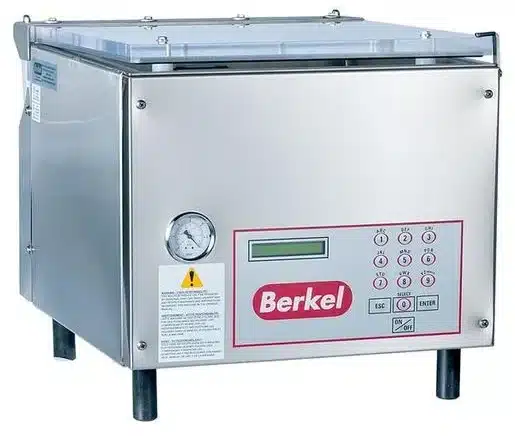Commercial Food Saver Guide

Food waste is no friend to the restaurant industry, where keeping food costs under control is vital to the bottom line. For the highest-quality meals, you want to be able to buy the best, freshest possible products — and not lose them for not using them!
A food vacuum sealer will help rescue your ingredients and even sauces, stews and full meals from the trash — and do so in a way that preserves flavor and freshness over a period several times longer than simple refrigeration in a container. It’s the sort of quality addition to a commercial kitchen that we love at Eleven36 — a win-win for the customer and the restaurateur alike.
What is a Foodsaver?
A Foodsaver is a vacuum sealer model that removes all the air from a bag containing food and vacuum seals the ends of it with heat so that the bag is fully closed and airtight. Once sealed, you can place your vacuumed bag into the refrigerator like you would any normally contained product — except a vacuum sealed bag will help your food last as many as three to five times longer!
A Foodsaver doesn’t just extend the life of your food, however. It meaningfully extends its life, preserving freshness far better than conventional modes of refrigeration by removing the air that breaks down food and contributes to mold and bacterial growth. Open up vacuum sealed fresh fruits and be transported back to the orchard from which they came. Or vacuum seal salmon in bulk and keep it in the freezer for a few years. A Foodsaver will also help preserve bread, nuts, crackers, flour and other staples, too.
There are some foods you don’t want to seal — whole apples, bananas, mushrooms, raw onions and garlic, soft cheeses, cabbages and lettuce, freshly cooked veggies or any food containing anaerobic bacteria that might thrive without oxygen — but for everything else, vacuum sealing is all upside.
How to Use a Foodsaver to Make Your Delicious Food Last Longer

Food Savers come in a few different models, but all are easy to use. A chamber vacuum sealer can sit on the floor or on a countertop and basically looks like a big box that can vacuum seal effectively, even with multiple bags at once. It’s a great option for businesses, because it allows you to vacuum seal anything that can be vacuum sealed, including liquids without worrying about spillage. A smaller external vacuum sealer looks a little bit like a printer, except instead of paper, you are feeding it a bag to vacuum seal.
So how do you use your Foodsaver? Here’s a step-by-step guide.
- Prepare your food items for sealing. Make sure you have the right kind of vacuum sealer bags. Make sure the food you are trying to seal is not going to degrade if sealed (see the list of foods not great for sealing above). Make sure anything you have heated and want to seal has sufficiently cooled. If your intention is to vacuum seal for a sous vide or any future cooking/boiling of the bag itself, make sure your bags are boil-safe.
- Place your food inside the bags, leaving space for the vacuum sealer to seal according to instructions. Line up the bag so that the end of it can be sealed.
- Press the button to vacuum seal (whether it’s a chamber or an external vacuum sealer). Let it do its magic! For some models, you will need to press another button to then perform the seal separately from the vacuuming.
- Once sealed, you can store your foods in the fridge, freezer, or shelf if they do not require refrigeration.
Pretty easy, right? Ease of use is one of the perks of the vacuum sealer machines Eleven36 provides. But you can make things even easier by avoiding common mistakes.
- Don’t vacuum seal a liquid that hasn’t been properly cooled — it can boil in its bag and cause a mess in the sealer. Once cooled, you won’t have that problem.
- Avoid air pockets for maximum freshness. You can do this by using a rolling pin to press your meat, for example, into each corner of the vacuum bag before using an external vacuum sealer. Or use a quality chamber vacuum sealer, like the kind sold by Eleven36, which will pump air all through the bag before it vacuums it out to address this very problem.
- Don’t vacuum seal hot food, period — trapping the heat in the bag will help promote bacteria growth, even when it’s put in the fridge.
- Blanch vegetables before sealing — cauliflower, brussel sprouts, and other cruciferous vegetables when fresh emit gas, which can build up in the bag. Blanching for an appropriate period of time will stop the vegetables from producing these enzymes.
Why You Should Think About Vacuum Sealing Food
The extension of flavor and life for your foods that a vacuum sealer can offer is impressive. Take meats. Beef and poultry can last about 6 months in a freezer if just placed in a non-vacuum sealed bag. Vacuum seal it and those goods can last 2 to 3 years. Vacuum seal hard cheeses and you can extend their life in the fridge from 2 weeks to 8 months. That’s a big deal! Something fresh and seasonal, like berries, can have their freshness and life extended from 1 to 6 days by ordinary storage means to 1 to 2 weeks in a vacuum sealed bag.
All of these options with food make the process of choosing items for your menu easier and more cost-effective. A vacuum sealer from Eleven36 allows you to use your culinary imagination to the fullest without worrying about wasting food unnecessarily.
Vacuum sealing can also help you make incredible sous vide preparations. It also makes for a particularly fresh and delicious marinade.
Foodsaver Uses: Versatility and Applications
There are a number of ways to use a quality Foodsaver from Eleven36 to boost your menu and help your bottom line.
Incorporate more local ingredients. Knowing you can vacuum seal berries and other fresh fruits can help you buy more local ingredients in bulk, lowering your per unit price and allowing you to add more flair to dishes.
Marinate fast! Vacuum sealing helps speed up the absorption of liquid in meats and vegetables; you can vacuum seal your way to a delicious marinade in just 30 minutes of marination time!
Sous vide your heart out. You need a vacuum sealer to be able to cook sous vide properly, but once you have one, you can enjoy to its fullness all the flavor offered by this water-immersion technique.
Save sauces and liquids. You don’t need to throw away old sauces! You can preserve them at the height of their freshness by vacuum sealing them when cool.
Create a takeout side business. Restaurants continue to trend toward giving customers options to enjoy their cuisine at home. You can make your sauces, meats, and whole meals more marketable by vacuum sealing them and offering them to customers to heat up in their own place.
Choosing the Vacuum Sealer That Works Best for You

What do you need to think about to make sure you are getting your vacuum sealer purchase right?
External vs. chamber. There are two types of vacuum sealers, the external sealer (that looks like a printer, described above) and the chamber sealer. The chamber sealer is more expensive and takes up more space, but cannot be beat in terms of its ability to seal multiple bags or to seal liquids, sauces and other common items you want to save in the foodservice business. Chamber vacuum sealers are found frequently in commercial establishments.
Gas flush. To maintain color in food, especially particular delicate foods, a gas flush can be useful. What this does is ensure that no oxygen is left in the bag by replacing it with a stabilizing gas flush. This provides maximum flavor and lifespan preservation.
Reliable manufacturer. When you buy from Eleven36, we always make sure your product is from a brand that we trust, and that we can back you up if you have any maintenance needs. Once you get used to a vacuum sealer, you will be wanting to rely on it as part of your workflow — and we make sure you have high-quality machines that can keep up with your needs, and customer service that navigates any hiccups along the way effectively. It may mean a little extra money in your initial investment, but it sure beats having to replace a sealer that breaks — and there are unfortunately many vacuum sealers out there that do not live up to the standards of preservation the best units provide.
Vacuum Sealing vs. The World
While a Foodsaver is an excellent tool, it’s not the only storage game in town. It’s just one of the best!
The advantages of vacuum sealing versus just zipping up meat or veggies in a bag and putting them in the freezer have already been discussed. Vacuum sealing also provides a much more versatile option over canning in terms of foods you can seal and the ease of the process.
Vacuum sealing is really quick — it takes about an extra minute over tossing something in a bag into your freezer or fridge, and extends the life of that meal component several times over! Making the investment in a vacuum sealer from Eleven36 will save thousands of dollars a year at least in food waste.
Taking Care of Your Vacuum Sealer
In addition to helping you save money on food waste and boosting the freshness of your menu, a vacuum sealer is easy to clean, so it won’t take up much of your staff’s time, either. Your unit will come with instructions on how to handle the specific components, but many are often dishwasher-safe. Be careful not to scratch or use abrasive cleaners. Also check according to instructions on your vacuum pump and your gaskets. Some vacuum pumps are dry; others will need their oil changed from time to time. If anything comes up that you don’t know how to deal with, call us at Eleven36 and we are happy to jump in and help, lending decades of experience in the foodservice industry and intimate knowledge of the products we sell.
Now that we’ve covered everything there is to know, it’s time to start sealing! Pursue Eleven36’s selection of high-quality vacuum sealers to find one that best suits your business today. Your customers and the planet will thank you for all the extra delicious, fresh food that will make it to your plates!
